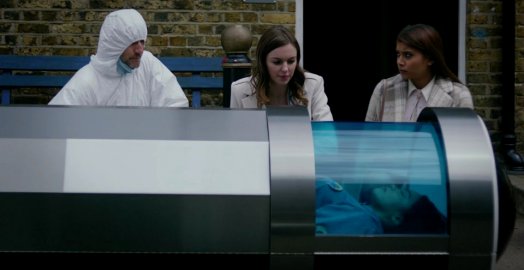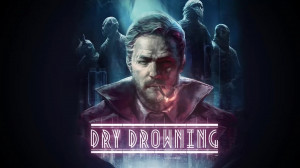Review for The Complex

Game information
Adventure Gamers Awards
In the not-too-distant future, the latest innovation in medical science will be the development of nanocells, which can enhance the regeneration of both bone and blood, so that people can carry microscopic hospitals with them wherever they go. Naturally such technology can’t just be shared altruistically – medicine is big business, after all – and anything that can create such dramatic physiological changes could be used for both good and ill. When terrorists break into the Kensington Complex to secure this nanocell technology, lead researcher Amy Tennant knows she’s going to have a pretty rotten day. Thankfully, a pretty rotten day for her means a short but intensely exciting, choice-driven experience for players in the interactive FMV thriller The Complex.
With gameplay consisting entirely of making choices at predetermined spots, The Complex is a ninety-minute movie along the lines of Telltale’s story games, but with live action recordings using real actors, sets, and filmmaking techniques, and without the Quick Time sequences. The FMV production values are high, the video quality excellent, and the actors all do a good job of portraying their various characters in a story about a believable near-future scientific development that treats its subject matter seriously but still allows for a sense of humour and a degree of fun (for the player, if not necessarily the characters).
Players take on the role of Amy, making various decisions for her throughout the game. These appear as two to four buttons with short descriptions, placed side by side at the bottom of the screen. By default, a limited amount of time is given to make a choice before the game selects one automatically. This lends a sense of urgency, especially as the terrorists get closer and closer to breaching the lab inside which Amy is barricaded. I found the time constraint a bit too tight in a couple of situations, as it wasn’t long enough even to read the presented options, let alone think about which one I wanted to select. Fortunately, the game comes with a setting to have it pause instead of selecting an option automatically when the timer runs out, which I used on a second play through. It does take away a bit of the tension, but not so much as to be a detriment to the overall narrative.
The story locks Dr. Tennant and the sarcastic Rees Wakefield inside a lab in the bowels of the Kensington complex. The two were friends (and perhaps more) when they served as medics in war-torn Kindar five years previously, until Rees couldn’t hack the pressure and ran out when Amy had two patients dying right in front of her. Now they’ve been reunited to treat a woman named Clare, who collapsed, spitting up blood on one of London’s C-trains. It’s not spoiling anything to reveal that Clare was injected with Amy’s still-experimental nanocell technology and that it’s now wreaking havoc on her body. Against the backdrop of this already tense situation, the terrorists break into the building and begin making their way past various security obstacles to try to reach the lab.
Amy and Rees are not completely cut off. They have a videoconference line to the office of Nathalie Kensington, head of the company and the one who initially spearheaded the nano research with Amy’s help. Nathalie is assisted by her trusty secretary Emily and by Parker Caplani, the man who designed the complex and its security measures. Choices are occasionally presented to accept their help as Amy tries to escape her confinement or to reject any teleconferencing calls coming from the office as certain devastating revelations are made, including Nathalie’s desire to have Amy harvest a lethal amount of Clare’s blood to preserve the only remaining viable nanocells.
The stakes are high and made all the more convincing by the actors’ portrayals. Rees is the joker in the group, always ready with a witty or sarcastic remark, but trapped alongside Amy with the terrorist drawing closer, his nerves get increasingly rattled as the situation intensifies. Nathalie has poured her heart and soul into the company and its technology. Doggedly pragmatic, she has no problem with the deaths of either Clare or the terrorists if it will preserve her precious nanocells. This understandably makes both Amy and Rees concerned – after all, if Nathalie is willing to condemn a sick patient, who else might she be willing to sacrifice? Emily and Parker get the least screen time, but still come across convincingly. Remaining at a distance from the action and essentially watching it “on TV” through security feeds, it’s obvious the circumstances aren’t nearly as tense for them (in fact, at one point it appears the two may even be arranging a date in the background). Clare, meanwhile, locked inside a tubular bio-bed, comes across authentically as someone who is both suffering and trying to impart an important secret to Amy and Rees.
Of all the cast, Michelle Mylett, who plays Amy, has quite possibly the hardest task as her performance needs to change quite significantly depending on the choices players make. Based on how the story branches, she has to be believable as both caring and cold. At times she’ll convey measured, scientific intelligence, and at others she’ll show her frustrations, even resorting to getting physical on occasion (quite impressive given her short stature). She demonstrates her ability to hold a grudge or forgive others as well as herself. Mylett manages this range of attitudes and emotions quite well, and even when acting standoffish towards the other characters, between her performance and the writing she never becomes unrelatable or too unlikeable as a protagonist under serious duress.
Most of the dilemmas are well thought out and you’ll have enough information, once you’ve moved beyond the start of the experience, to at least have a sense of where your decision is likely to take things. It is a choice-based game, however, and is therefore susceptible to the problems of most such games. There are times when you’ll have no idea why an option is being presented, never mind what the repercussions (if any) might be. Then there are times you’ll make a decision and the result will be completely different from what you anticipated, and others when the game ignores your choice altogether to continue on its predetermined path. Instances of these types of issues are rare, but there is no free save ability in The Complex, only a progressive autosave. If something happens that you didn’t intend, in order to explore different story branches the entire game must be played again from the beginning (although at least already viewed scenes can be skipped).
As events unfold and decisions are made, the main narrative direction remains largely the same. However, little alterable nuances show up here and there. Choices generally consist of Amy being compassionate or antagonistic to those around her, or with her being clever or a brute to overcome obstacles such as when debating between a scalpel to use as a screwdriver or a microscope to use as a battering ram. Some scenes only appear if specific choices have been made, while others play out differently depending on prior decisions. This culminates in a climax where one of nine endings can be experienced and different combinations of characters may or may not survive.
After the credits have rolled, a summary page is displayed showing the levels of Amy’s various personality traits (honesty, bravery, intelligence, and so on), how good her relationship with the different major characters is, which of those characters lived or died, and how many of the game’s 196 scenes were discovered, this last being measured across all playthroughs. My first time around, where I tried as best I could to play Amy as a compassionate, caring person, I encountered only 81 scenes, was granted an assessment of “Altruistic” and four people died. On my second play, I went in the opposite direction and made Amy as selfish and cold-hearted as I could, which resulted in an assessment of “Neurotic,” every one of the main characters dying, and a cumulative total of 126 scenes discovered. It was really nice having such a clear summary of the results of my choices and overall progress.
Far less clear is what I encountered at the beginning of the game. In the first 10-15 minutes, the story throws a lot of details at you. Much of this ultimately proves to be fluff. From references to the first manned mission to Mars, to securing further private funding for the development of the nanocell tech, to establishing geopolitical concerns, there is a great deal of information that seems important but simply vanishes from the plot shortly after. At the same time, all of this is intercut with clips of Clare being shown to be deathly ill on board her train.
With so much detail and all the jumping back and forth to the sick woman, I initially felt rather lost, but upon replaying the game I was able to ignore all the needless early exposition and focus on what was actually important. Fortunately, once the info dump is over and the terrorists enter the complex, the game settles down into a much more easily followed thriller. Characters’ emotions run high and the situation gets increasingly tense and more and more engaging.
A couple other factors help to ratchet up the atmosphere as well. First is the setting. Except for the occasional glimpse of Nathalie’s corporate office on camera via videoconferencing calls, and of the path the terrorists are taking through the complex to reach Amy and Rees as seen on security feeds, the bulk of the game takes place in the lab itself. As the story progresses, remaining in the one location, with its gleaming metal surfaces and sterile surgical equipment, really does start to feel claustrophobic. Especially when the terrorists begin banging on the door.
The benefit to keeping the action localized is that it allowed the production’s budget to be more focused. As a result, Amy’s lab genuinely feels like a space where cutting-edge medical research might be conducted. Assorted lab benches on wheels have been arranged among white and metal surfaces. High-tech computer displays sit alongside glass whiteboards. Even the actors are dressed in matching research suits with clean lines. Add in some clever use of coloured lighting at times to alter the general aesthetic and it really does create a nice atmosphere. This mood is further enhanced by the musical accompaniment. The instrumental pieces sit in the background for much of the game but have that nervous energy, tension-building energy of the score in a Jason Bourne film.
While The Complex gets off to a bit of a bumpy start with its information overload, once it shifts into its thriller mode, it makes for a very tense and engaging choice-driven tale with that feeling of racing against time (even when allowing the game to be paused for decisions). As an interactive movie there are no puzzles, exploration, or other traditional adventure elements, but anyone who enjoys a riveting life-or-death story with a bit of moral ambiguity thrown in for good measure will find this is just what the doctor ordered.




























